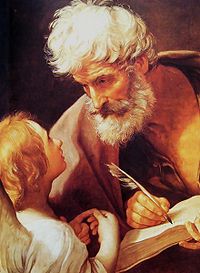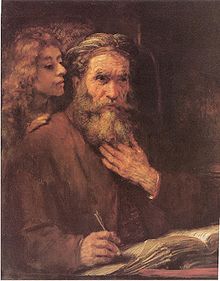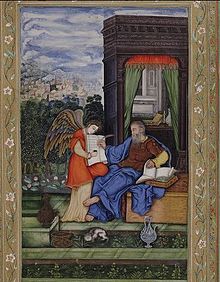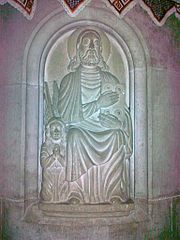- Saint Matthew
-
Saint Matthew the Evangelist 
Saint Matthew and the Angel
by Guido ReniApostle, Evangelist, Martyr Died near Hierapolis or Ethiopia Honored in Roman Catholic Church
Eastern Orthodox Churches
Eastern Catholic Churches
Anglican Communion
Lutheran Church
Aglipayan Church
some other Protestant ChurchesCanonized pre-congregation Major shrine Salerno, Italy Feast 21 September (Western Christianity)
16 November (Eastern Christianity)Attributes Angel Patronage Accountants, Salerno, Italy, and others, see[1] Matthew the Evangelist (מתי/מתתיהו, "Gift of Yahweh", Standard Hebrew and Tiberian Hebrew: Mattay or Mattithyahu; Septuagint Greek: Ματθαῖος, Matthaios) was, according to the Bible, one of the twelve Apostles of Jesus and one of the four Evangelists.
Contents
Identity
Among the early followers and apostles of Jesus, a Matthew is mentioned in Mt 9:9 and Mt 10:3 as a former tax collector from Capernaum who was called into the circle of the Twelve by Jesus. He is also named among the number of the Twelve, but without identification of his background, in Mk 3:18, Lk 6:15 and Acts 1:13. He is often equated with the figure of Levi, son of Alpheus, also a tax collector, who is mentioned in Mk 2:14 and Lk 5:27. He may have collected taxes from the Hebrew people for Herod Antipas.[2][3][4] Matthew was "called" by Jesus of Nazareth to be one of the Twelve Disciples.[3][5][6][7][8] According to the New Testament he was one of the witnesses of the Resurrection and the Ascension.
Early life
Matthew was a first century Galilean (presumably born in Galilee, which was not part of Judea or the Roman Iudaea province) and the son of Alpheus.[5] During the Roman occupation (which began in 63 BC with the conquest of Pompey), Matthew collected taxes from the Hebrew people for Herod Antipas, the tetrarch of Galilee. His tax office was located in Capernaum. Jews who became rich in such a fashion were despised and considered outcasts. However, as a tax collector he would have been literate in Aramaic and Greek.[2][9][10][11][12]
It was in this setting, near what is today Almagor, that Jesus called Matthew to be one of the Twelve Disciples. After his call, Matthew invited Jesus home for a feast. On seeing this, the Scribes and the Pharisees criticized Jesus for eating with tax collectors and sinners. This prompted Jesus to answer, “I came not to call the righteous, but sinners” (Mark 2:17)
Matthew's Ministry
When Matthew is mentioned in the New Testament, he is sometimes found paired with Thomas. The New Testament records that as a disciple, he followed Jesus, and was one of the witnesses of the Resurrection and the Ascension. Afterwards, the disciples withdrew to an upper room (Acts 1:10-14)[13] (traditionally the Cenacle) in Jerusalem.[14] The disciples remained in and about Jerusalem and proclaimed that Jesus was the promised Messiah.
Matthew may also be mentioned in the Talmud.[15]
Matthew, for 15 years, preached the Gospel in Hebrew to the Jewish community in Judea.[citation needed] Later in his ministry, he would travel to Gentile nations (presumably following Jesus' Great Commission) and spread the Gospel to the Ethiopians, Macedonians, Persians, and Parthians.[citation needed][14] The Roman Catholic Church and the Orthodox Church each hold the tradition that Matthew died as a martyr.[11][16]
Matthew's Gospel
Although the first of the Synoptic Gospels is technically anonymous,[17] traditionally the Gospel of Matthew was held to be written by the apostle.[18] As a government official in Capernaum, in "Galilee of the Gentiles", a tax-collector would probably have been literate in both Greek and Aramaic.[19] Greek was the language used in the market-place.[20] Some early church fathers recorded that Matthew originally wrote in "Hebrew", but still regarded the Greek text as canonical.[21]
Many scholars today, such as Raymond E. Brown, believe that "canonical Matt[hew] was originally written in Greek by a non-eyewitness whose name is unknown to us and who depended on sources like Mark and Q",[22] a theory known as Markan priority. However some scholars, notably Craig Blomberg, disagree variously on these points.[23][24][25] Some scholars posit a Matthean priority.
Non-canonical or Apocryphal Gospels
In the third century Jewish-Christian Gospels attributed to Matthew were used by Jewish-Christian groups such as the Nazarenes and Ebionites. Fragments of these gospels survive in quotations by Jerome, Epiphanius and others. Most academic study follows the distinction of Gospel of the Nazarenes (26 fragments), Gospel of the Ebionites (7 fragments), and Gospel of the Hebrews (7 fragments) found in Schneemelcher's New Testament Apocrypha. Critical commentators generally regard these texts as having been composed in Greek and related to Greek Matthew.[26] A minority of commentators consider them to be fragments of a lost Aramaic or Hebrew language original.
The Infancy Gospel of Matthew is a seventh century compilation of three other texts: the Protevangelium of James, the Flight into Egypt and the Infancy Gospel of Thomas.
Origen said the first Gospel was written by Matthew.[27][28] This Gospel was composed in Hebrew near Jerusalem for Hebrew Christians and translated into Greek, but the Greek copy was lost. The Hebrew original was kept at the Library of Caesarea. The Nazarene Community transcribed a copy for Jerome which he used in his work.[29] Matthew's Gospel was called the Gospel according to the Hebrews or sometimes the Gospel of the Apostles [30][31] and it was once believed that it was the original to the Greek Matthew found in the Bible. However this has been challenged by modern biblical scholars such as Bart Ehrman and James R. Edwards.[32][33][34] [35] [36]
Jerome relates that Matthew was supposed by the Nazarenes to have composed their Gospel of the Hebrews[37] though Irenaeus and Epiphanius of Salamis consider this simply a revised version canonical Gospel. This Gospel has been partially preserved in the writings of the Church Fathers, said to have been written by Matthew.[35] Epiphanius does not make his own the claim about a Gospel of the Hebrews written by Matthew, a claim that he merely attributes to the heretical Ebionites.[36]
In Islam
The Qur'an speaks of Jesus's disciples but does not mention their names, instead referring to them as "helpers to the work of God".[38] Muslim exegesis and Qur'an commentary, however, names them and includes Matthew amongst the disciples.[39] Muslim exegesis preserves the tradition that Matthew, with Andrew, were the two disciples who went to Ethiopia to preach the message of God.
Commemoration
Matthew is recognized as a saint in the Roman Catholic, Eastern Orthodox, Lutheran[40] and Anglican churches. (see St. Matthew's Church) His feast day is celebrated on 21 September in the Westand 16 November in the East. (For those churches which follow the traditional Julian Calendar, 16 November currently falls on 29 November of the modern Gregorian Calendar). He is also commemorated by the Orthodox, together with the other Apostles, on 30 June (13 July), the Synaxis of the Holy Apostles. His relics are said to be preserved in the Salerno Cathedral in Italy.
Like the other evangelists, Matthew is often depicted in Christian art with one of the four living creatures of Revelation 4:7. The one that accompanies him is in the form of a winged man. The three paintings of Matthew by Caravaggio in the church of San Luigi dei Francesi in Rome, where he is depicted as called by Christ from his profession as gatherer, are among the landmarks of Western art.
See also
References
- ^ "Saints.SQPN BLOG: Saint Matthew the Apostle". Saints.sqpn.com. http://saints.sqpn.com/saint-matthew-the-apostle/. Retrieved 2010-02-22.
- ^ a b Werner G. Marx, Money Matters in Matthew, Bibliotheca Sacra 136:542 (April–June 1979):148- 57
- ^ a b Encyclopædia Britannica: Saint Matthew the Evangelist
- ^ The International Standard Bible Encyclopedia: Matthew
- ^ a b Mark 2:14
- ^ Matthew 9:9
- ^ Mark 2:15–17
- ^ Luke 5:29
- ^ Catherine Hezser Jewish literacy in Roman Palestine p172 2001 "Even if they were pious and able to read the Hebrew Bible and/or literate in Greek poetry and prose, the writing they had to do in every day life ... 24 For the evidence of tax receipts amongst the Judaean Desert papyri see section II. "
- ^ The Cambridge history of Judaism: 2 p192 ed. William David Davies, Louis Finkelstein "We are now touching upon that milieu in which Greek language and civilization were readily accepted in order to ... A great number of tax receipts on ostraca mainly from the second century BCE show how Jews, Egyptians and Greeks.. "
- ^ a b "The International Standard Bible Encyclopedia: Matthew". Studylight.org. http://www.studylight.org/enc/isb/view.cgi?number=T5861. Retrieved 2010-02-22.
- ^ Encyclopædia Britannica. "Encyclopædia Britannica: Saint Matthew the Evangelist". Britannica.com. http://www.britannica.com/EBchecked/topic/369730/Saint-Matthew-the-Evangelist. Retrieved 2010-02-22.
- ^ Anchor Bible Reference Library, Doubleday, 2001 pp. 130-133, 201
- ^ a b
 "St. Matthew". Catholic Encyclopedia. New York: Robert Appleton Company. 1913.
"St. Matthew". Catholic Encyclopedia. New York: Robert Appleton Company. 1913. - ^ Bernhard Pick, The Talmud: What It Is and What It Knows of Jesus and His Followers, Kessinger Publishing, date? reprint 2006 p. 116
- ^ Eusebius, ''Church History'' 3.24.6. Books.google.ca. http://books.google.ca/books?id=DX89AAAAYAAJ&pg=PA299&dq=%22Eusebius+about+315%22+%22+Matthew,+having%22+%22+first+preached+to+the+Hebrews%22+%22go+to+other+people%22&num=100#v=onepage&q=%22Eusebius%20about%20315%22%20%22%20Matthew%2C%20having%22%20%22%20first%20preached%20to%20the%20Hebrews%22%20%22go%20to%20other%20people%22&f=false. Retrieved 2010-02-22.
- ^ Holman Concise Bible Commentary ed. David S. Dockery -2011 p402 "Strictly speaking, the Gospel of Matthew is anonymous. The titles of the Gospels were not added until the second century. But early church tradition unanimously ascribes this Gospel to Matthew."
- ^ D. R. W. Wood, New Bible Dictionary, InterVarsity Press, 1996. p 739.
- ^ Mark A. Chancey Greco-Roman culture and the Galilee of Jesus 2005 p162 "After Galilee was put under direct Roman administration in 44 CE, there would have been greater impetus for members of the upper class who wanted to ... It is easy to demonstrate that Greek was the language of the governmental sphere."
- ^ W. S. Vorster, J. Eugene Botha Speaking of Jesus: essays on biblical language, gospel narrative 1999 p295 "During that period Sepphoris was the administrative centre in Galilee. In 63 BCE Pompey's legions captured Jerusalem ... still spoken by most Jews, and Hebrew was probably still in use, Greek was the language used in the market-place."
- ^ Eugène-Jacques Jacquier (1847-1932) Catholic Encyclopedia 1911 Gospel of Matthew "The fact that the Fathers and all ecclesiastical writers, and even the Church itself from the very beginning, have used as canonical the Greek text of the Gospel known as St. Matthew's, not even excepting those who have expressly handed down that the Apostle Matthew wrote in his native tongue, proves for certain that this very Greek Gospel is identical in substance with the Gospel written by the same Apostle in his native language."
- ^ Brown, Raymond E., Introduction to the New Testament, Anchor Bible, 1997, p.210–211.
- ^ Howard Clark Kee (1997), p. 448
- ^ D. R. W. Wood, New Bible Dictionary (InterVarsity Press, 1996), 739.
- ^ Strobel, Lee. ”The Case for Christ”. 1998, citing Craig Blomberg
- ^ Vielhauer NTA1
- ^ Eusebius, ''Church History'' 6.25.4. http://books.google.com/books?id=Vs9YXAB_axYC&pg=PA18&dq=%22The+First+Gospel,+says+Origen%22++%22written+by+Matthew,+who+once+had+been+a+tax%22&num=100#v=onepage&q=%22The%20First%20Gospel%2C%20says%20Origen%22%20%22written%20by%20Matthew%2C%20who%20once%20had%20been%20a%20tax%22&f=false. Retrieved 2010-02-22.
- ^ Jerome, ''Commentary on Matthew'' 2.12. http://books.google.com/books?id=X2VLANXcZsYC&pg=PA14&lpg=PA14&dq=Matthaei+Authenticum#v=onepage&q=Matthaei%20Authenticum&f=false. Retrieved 2010-02-22.
- ^ Jerome, ''On Illustrious Men'' 3. http://books.google.com/books?id=uqzY1zBtKg0C&pg=PA10&dq=%22matthew+surnamed+levi%22+%22composed+a+gospel+of+Christ+at+first+published+in+Judea+in+Hebrew%22&num=100#v=onepage&q=%22matthew%20surnamed%20levi%22%20%22composed%20a%20gospel%20of%20Christ%20at%20first%20published%20in%20Judea%20in%20Hebrew%22&f=false. Retrieved 2010-02-22.
- ^ John Bovee Dods, ''The Gospel of Jesus'', G. Smith Pub., 1858 pp. iv — vi. Books.google.ca. http://books.google.ca/books?id=c2ANAAAAYAAJ&pg=PR4&dq=matthew+%22Gospel+of+the+Apostles%22+OR+%22Gospel+of+the+twelve+Apostles%22+%22various+names%22+%22this+book+of+which+we+speak+contained%22+%22the+life+of+Christ%22&cd=2#v=onepage&q=matthew%20%22Gospel%20of%20the%20Apostles%22%20OR%20%22Gospel%20of%20the%20twelve%20Apostles%22%20%22various%20names%22%20%22this%20book%20of%20which%20we%20speak%20contained%22%20%22the%20life%20of%20Christ%22&f=false. Retrieved 2010-02-22.
- ^ Jerome, ''Against Pelagius'' 3.2. Books.google.ca. http://books.google.ca/books?id=Zm1v-c7fGmgC&pg=PA472&dq=%22gospel+according+to+the+hebrews%22+%22Gospel+according+to+matthew%22+%22gospel+according+to+the+apostles+%22in+Hebrew+characters%22+copy&num=100#v=onepage&q=%22gospel%20according%20to%20the%20hebrews%22%20%22Gospel%20according%20to%20matthew%22%20%22gospel%20according%20to%20the%20apostles%20%22in%20Hebrew%20characters%22%20copy&f=false. Retrieved 2010-02-22.
- ^ See also the two-source hypothesis
- ^ James R. Edwards, The Hebrew Gospel & the Development of the Synoptic Tradition, Wm. B. Eerdmans Publishing Co, 2009. pp 245-258
- ^ Bart Ehrman, Jesus: Apocalyptic Prophet of the New Millennium, Oxford University Press, 1999 p. 43
- ^ a b Mills, Watson E., Richard F. Wilson and Roger Aubrey Bullard, Mercer Commentary on the *New Testament, Mercer University Press, 2003, p.942
- ^ a b "What they call a Gospel according to Matthew, though it is not entirely complete, but is corrupt and mutilated - and they call this thing 'Hebrew'!" id=rJw3AAAAIAAJ&pg=PA129&dq=Ebion+"corrupt+and+mutilated"&lr=&cd=1#v=onepage&q=Ebion_"corrupt_and_mutilated"&f=false Panarion, 13. English translation by Frank Williams (Leiden, Brill, 1987)
- ^ Jerome and the Early Church Fathers
- ^ Qur'an 3:r49-53
- ^ Historical Dictionary of Prophets In Islam And Judaism, Brandon M. Wheeler, Disciples of Christ: "Muslim exegesis identifies the disciples as Peter, Andrew, Matthew, Thomas, Philip, John, James, Bartholomew, and Simon"
- ^ Evangelical Lutheran Church in America: Lesser Festivals, Commemorations, and Occasions, Evangelical Lutheran Worship, page 57. Augsburg Fortress.
External links
- St Matthew the Apostle from The Golden Legend
- Apostle and Evangelist Matthew Orthodox icon and synaxarion
- Synaxis of the Holy Apostles
Calling of Matthew
Life of Jesus: Ministry EventsPreceded by
Hometown Rejection of Jesus,
"Physician, heal thyself"New Testament
EventsFollowed by
New Wine into Old WineskinsTwelve Apostles of Jesus Christ Peter · Andrew · James son of Zebedee · John the Apostle · Philip · Bartholomew · Thomas
Matthew · James son of Alphaeus · Jude · Simon the Zealot · Judas Iscariot · MatthiasCategories:- Christian martyrs of the Roman era
- Eastern Orthodox saints
- Saints from the Holy Land
- Twelve Apostles
- 1 BC births
- 34 deaths
- Burials at Salerno Cathedral
- 1st-century Christian martyr saints
- Anglican saints
- People celebrated in the Lutheran liturgical calendar
- Biblical apostles
Wikimedia Foundation. 2010.





